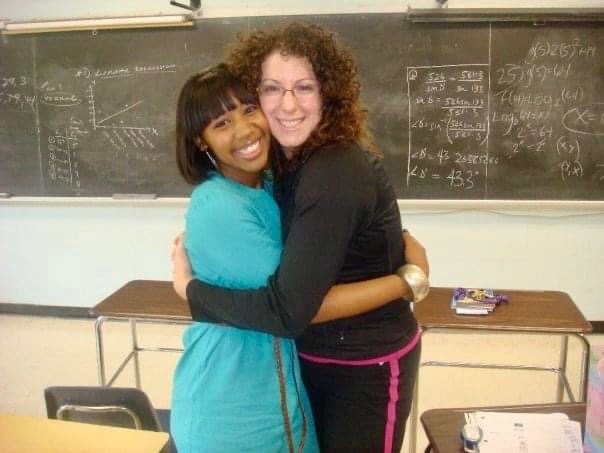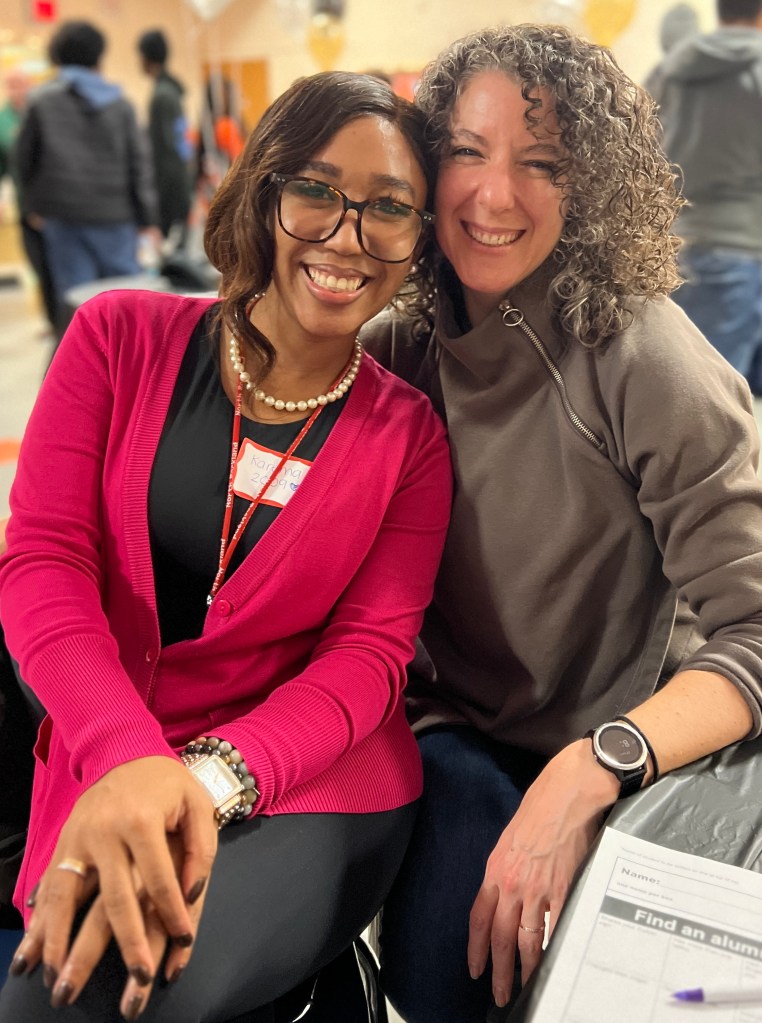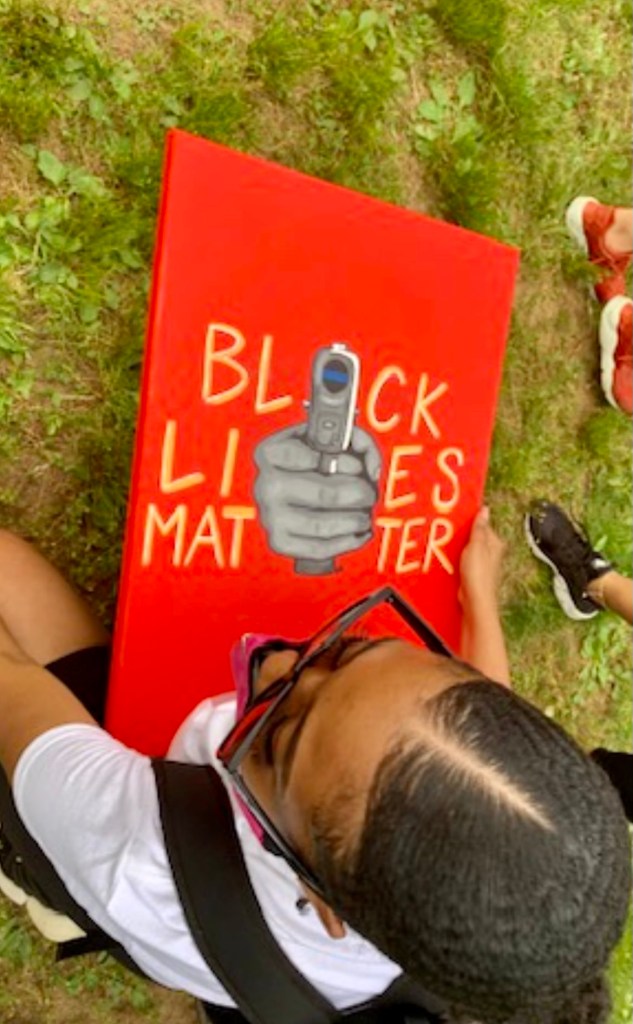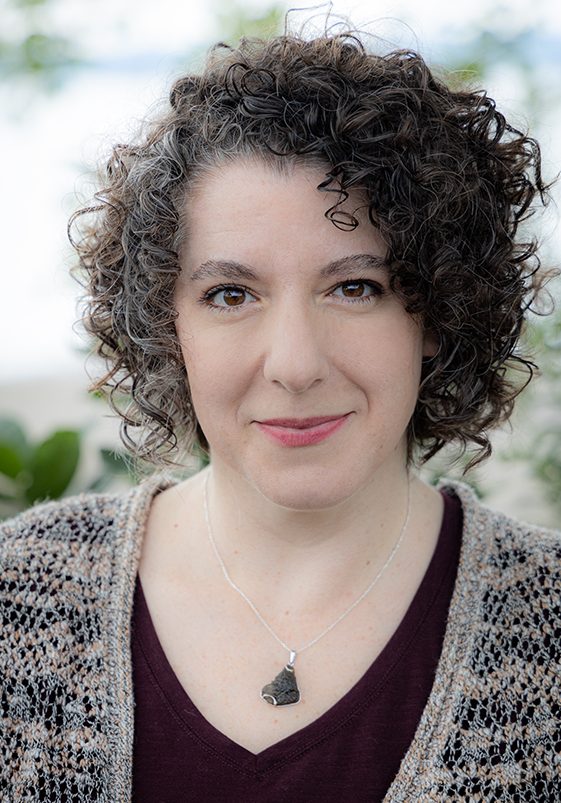
Karema Brown
Welcome to the final episode of season three of Changed for the Better! I can’t think of a better person to have join me for this momentous occasion: an educator with the same heart for her students as mine who is doing all she can to improve the school experience for her kids.
Karema Brown, Spring Valley class of 2009, graduated with my episode 5 guest Stephanie Lauredent-Diasio.
I remember this beautiful woman as a bright, sassy, vivacious teenager. She knew who she was, what she wanted, and was not afraid to express herself to the world. I enjoyed teaching her in my Multicultural and Ballet Dance classes, and I tried to get her to gravitate to Thespians, to no avail. She chose to admire the theater activities from afar, instead focusing on her in-class dance experience and, more importantly, her future as an educator.
Karema and me on her last day of high school (not in my studio – those math equations would NEVER be on my blackboard…)

After graduation, she received a Bachelor’s of Science with certifications in Early Childhood & Childhood Education from Iona College, and a Masters of Science in Literacy Education from Hunter College. She also has certificates in educational leadership, school building and school district leadership. Like I said, she is a woman who knows what she wants and makes it happen.
At her core, her greatest interest is in improving the educational process for children. She is a literacy specialist, and her first job was for the NYC Department of Education, where she quickly became a model ELA teacher in the Learning Partners Program, a school reform program that promoted inter-school collaboration to maximize student achievement. In the six years she was there, the students’ reading and writing levels went from 10% on grade level to almost 60%. She was a major force in that process of change.
In 2019, knowing she needed a change, Karema took a position closer to home in the North Rockland school district teaching literacy at the elementary level, and has joined school & district committees to develop new partnerships and support initiatives. Today, she is an ELA instructional coach at Haverstraw Elementary School.

Just before we sat for this interview, I had the pleasure of seeing Karema in person at Spring Valley’s annual Alumni Night, and when I saw her, my eyes lit up. I was so taken by the woman she has become, perhaps a little more demure, but just as thoughtful and energetic as I remember her teenage self.
What warms my heart is how she followed through with her intention to become an educator. We spoke at length about her career, for which she has built quite the resumé in a relatively short time, and takes the utmost pride. She is, and always has been, on an upwards trajectory to do her part for the children she serves.
At her core, Karema’s personal mission is one of service. She is the proud daughter of a now-retired Spring Valley police officer, and she grew up with the phrase “serve and protect” running through her veins. But, being the child of the badge comes with it’s challenges, and it impacted how she presented herself to the world. She often felt the need to wear a protective mask as she navigated her world, both to create a facade of strength and to hide the strong emotions she had difficulty processing. In her adolescence, being her authentic self was not her focus; holding it together was her modus operandi.
The mask she wore served to protect the ones she loved. Her mother, who was her moral compass and the model for how she carried herself, exemplified the inner strength that young Karema emulated. Her father, a pillar of his community, fostered her dedication to serving hers. They both cultivated the work ethic and passion for the things that she finds most meaningful. Karema wanted to make sure she was enough to make her parents proud, and often did not give herself the space to be vulnerable.
My adolescent self was very much functioning as my five-year-old self: wanting to be seen, wanting to be loved, wanting to keep the peace, and by doing so, I became a martyr in ways and masked so that I could ensure that people around me were okay. In doing so, at times it cost me to feel angry when I was by myself. I wanted so badly to put out into the world what I wanted to receive.
Now, Karema has embraced the power of vulnerability, and has learned to give herself the space to process and express her emotions. She proudly models that as a strength as she demonstrates healthy ways for her students to do the same. In the beginning of our chat, Karema allowed her vulnerable self to shine through with a few tears after the introduction:
I’m a bit emotional because I believe that words have immense power over who and what you become. Hearing you describe me as my young self reminded me of my “why.”
The dance studio
For someone as serious, driven, and focused as Karema, the dance studio provided a safe place where she could have fun. The space gave her the permission to “let loose” and explore other facets of herself that were not at the forefront of her self-expression.
It let me tap into skills that I had that I shied away from . You speaking to me reminded me that I embody multiple skills where I don’t have to box myself in. I can be strong in academics, I can be an artist, but part of that artistry is the child that survived and gives themselves permission to just simply be in the moment and have fun in community.
The all-inclusive community in the studio resonated strongly with Karema, whose core values compelled her to always someone to speak out for the marginalized. Seeing the variety of people, abilities and backgrounds that were represented in the studio space, and how the natural tendency to treat people as “other” was neutralized there, made for a comfortable space for her to be.
Karema’s emotional life was also validated there, and gave her a way to process her emotional “stuff” outside of her home.
Being in your studio gave me space to know that I didn’t have to do it by myself. In school is where you negotiate who you are as a person; but it has to be a safe space and there has to be an adult that offers that space for you to feel comfortable doing so.
Now, she is creating safe spaces for children to navigate their emotional lives. When Karema was about 23, she did some reflection about her position as an educator, particularly the importance of her role as a black educator.
I said to myself, I understand that a higher source has given me this position, and my presence has power. But, if I want to be more for children, I have to embody that. I need to do the work myself. If I want to teach children to have healthy boundaries, I have to practice having healthy boundaries myself. If I want to teach children how to move through a world or a system that was not necessarily built for them, then I have to model how to do so. If I want to show how much value there is in diversity and inclusivity, I have to show them real-life examples of that and build community.
Something she learned in the dance studio is to become a student of my students. This is a practice I am proud of: to connect with my kids, who are from all different walks of life, so that I can be a more effective educator. How? By checking in with them, talking to them, offering them support and assistance when they need it, seeing them for all they are in whatever emotional state they inhabit at any given moment. Karema was so appreciative of the random (or not-so random) check-ins; it made her feel seen and valued.
I keep remembering that we want to feel loved, cared for, and heard, so I make it my business to show children that I’m listening to them, that their words matter, it’s okay to feel how you’re feeling.
Abraham Maslow had the right idea: we can't teach students academics if their most basic needs aren't met. Read my blog post from December 2021 called What High School Students Need for more reflections on this aspect of his educational philosophy.
The child who is not embraced by the village
African Proverb
will burn it down to feel its warmth.
Taking up space despite imposter syndrome
Right on cue, Karema talked about the dreaded imposter syndrome.
Read more about imposter syndrome in episode 36, episode 35, episode 29, episode 25, and a post from my Geriatric Gymnastics series called Master Jack.
I think I’ve always been self-aware about what I can do and who I am. But despite that I always had this little feeling of not being enough. It stems from my five-year-old self. I can be the best in all that I am, and I’m hoping that someone will see me.
There’s been a great deal of self-reflection in her adulthood to reckon with the child yearning to be seen and chosen. Now, she acts because it’s who she is, not because she needs to be validated.
In the end, it’s about leaning into the idea that it’s okay to take up space in the world. We have to give ourselves the permission to acknowledge the value we have to offer and put ourselves in the forefront to actuate our worth for others. While we hear the positive feedback about how effective we are, the imposter syndrome can get in the way of absorbing the praise: there’s something in our brains that doesn’t fully believe it, or, doesn’t hold on to the reality of our efficacy. It feels like there’s always someone who can do it better.
What we have to remember is that while there may be others who do certain things better that we might, there’s no one else who can bring you to the space. Some people need to learn from you.
In this respect, I asked Karema what she might tell her adolescent self:
Remember your “why.” Stand firm in your values, but also know that you don’t have to perform or mask in order to receive accolades or be loved. You are worthy of that, simply because you are you.
The thin, blue line
As an adult, the convergence of her different identities has provided ample food for thought. The daughter of a Spring Valley police officer, who is also Black, Karema grew up in a protective bubble, taking pride in her father’s service to their community.
When George Floyd was murdered, like so many in our community, Karema was processing some complicated feelings.
I was extremely moved by all these things that had taken place in the world. I felt the theme of ‘I don’t fit one box’: I identify as a Black woman, my dad’s side is very multi-race, so my looks might be one thing but my background is another. My dad being an officer, identifies as a Black man, but he wears that badge with so much honor and pride and he would be the first person to put his life on the line for a community that he serves.
What took place with George Floyd, I felt that these two worlds were meeting. Where do I fit and how does that impact where I am?
Being an artist (a very talented one at that), Karema decided to put these questions on a canvas.


The red background represented the bloodshed due to police brutality. But growing up, she didn’t have that perspective: Police officers are community workers, they are valued, they are great, you call them if you need them. In the middle of the Black Lives Matter text is a gun being shot, you see the inside of the barrel, but inside the barrel I painted the thin, blue line because I see where two worlds meet. If an officer is in fear of his life, I could understand that. I also understand it being a Black woman.
Her rationale for the painting was to represent both sides that she aligns with. We have these polarized views and society has pinned Black vs Blue together. The reality is that those “sides” actually exist in tandem.
She recalled a story from her earlier teaching experience in the South Bronx, when Mike Brown was killed in 2014. Her students were distraught when the news came out.
I wanted to give them a space to process their feelings and I listened. Every single child in that classroom, at ten years old, had a negative encounter with a police officer. I asked myself ‘how does that impact the relationship or their perspective of police officers in the world?’
Knowing that this was not her experience, she wanted to bring her dad into her school community to show them everything she knew and respected about the badge. She invited him for class chats, career day appearances, and reached out to the local police precinct to arrange activities that shared a more positive experience between the police and the community they serve and protect.
When you are underrepresented in a space, you lack leverage to change it. If we want police officers, and a shift in it, then we have to bring in people from the community and connect with them. And, they need to see representations of themselves in the police force.
Race is a social construct
By providing these experiences, Karema facilitated avenues for change in her students’ perspective. Promoting diversity and inclusion fosters understanding amongst all aspect of community. Her experience in the multicultural bubble of Spring Valley helped her to see the value in not feeling “othered.” Rather, differences were (and are) celebrated every single day.
I didn’t realize that that was such a big thing until I started infiltrating new spaces to learn from people who didn’t grow up like me.
At Iona college, a predominantly white institution in 2009, Karema was her roommate’s first Black friend.
That broadened my perspective of systemic things that were established beyond me that I just didn’t know of. It ignited the fire that I already had of feeling responsible to prove otherwise: Black women, Black people, people that are marginalized in general can do anything equal to white counterparts. Race is a social construct; it’s infiltrated every part of life that we have. It helped define who I am as an educator.
Her goal as an educator is learning how to connect with all of her students, no matter their background or the way they look. She seeks to understand more about the people around her and the world they live in, so that she may play a more effective role in broadening their perspective of the world.
I’m seeing what you come in with, and how can I leverage that and support you in that moment?
Karema’s advice for today’s teens
Be mindful of who you surround yourself with. Energy contagion is real and the people that you surround yourself with truly impact the trajectory of your life. Seek good people and have a strong moral compass that you don’t have to deviate from who you are and your belief to be accepted. If you feel like something’s not right, it’s probably not right. Trust your gut.
External things don’t define you. Know who you are. Figure out what you value; what matters to you. Be strong.
Karema’s self-care strategies
- I take deep breaths, quite often. Co-regulating with others is one strategy in particular that she uses. Instead of telling someone to take a deep breath, she offers to do it with them. Then, they have the shared experience of calming together.
- Seeking out safe emotional spaces. When she is weathering the storms of life, she surrounds herself with the people with whom she feels comfortable co-regulating and re-centering. Allowing myself to feel; I can go some place, cry for a second, and pull myself together, and it’s okay for me to do that.
- Journal and read. She does this simultaneously. When she expands her knowledge in books, she journals to reflect on that knowledge
Final thoughts
What you put out into the world,
you receive.
As we were wrapping up our chat, Karema reflected how proud she was of herself and how she put herself out to the world in the last two years, which were particularly challenging for her, dealing with family illness and the passing of her beloved dog, Blue. During her personal storms, she worked hard to model the lessons and strategies that she wanted her students to learn as they navigated their own storms.
When the kids learned of her pup’s passing, they showed Ms. Brown the kind of love they had received from her. They made a sign that said “Some angels choose fur instead of wings.” On her desk were all of her favorite things: flowers, a strawberry lemonade, Reese’s. They had been paying attention attention to her, just as she had been paying attention to them. In their condolence card to her, they wrote loving words like “I’m here for you” and “Blue is in a better place.”
It was a full circle moment that Karema cherishes, just as our conversation was for me.
Here, at the close of three seasons, 40 interviews, and countless expressions of deep love and gratitude, I am excited to start year two of this incredible podcast experience. It has helped me to put my career in perspective, and provided a beautiful extension to my connection with the people who made me the teacher I am today. Because of them, I truly have been changed for the better.


Really enjoyed reading this one. I didn’t know her but wish I had.
Iris
LikeLike
This was amazing! I loved every second of this blog & podcast episode.
LikeLiked by 1 person
Thank you, Stephanie! I loved everything about making this episode!
LikeLike
shout out to Mrs brown I had her in the 3rd grade in ps 49 and I still remember her to this day💯❤️
LikeLiked by 1 person
She is an extraordinary woman who I am honored to now call my friend.
LikeLike